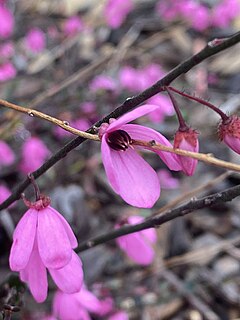
Tetratheca is a genus of around 50 to 60 species of shrubs endemic to Australia. It is classified in the botanical family Elaeocarpaceae, now known to encompass the family Tremandraceae, which the genus originally belonged to. It occurs throughout extratropical Australia, and has been recorded in every mainland state except the Northern Territory.
Tetratheca stenocarpa, commonly known as long pink-bells, is a small shrub in the family Elaeocarpaceae. It is endemic to Victoria in Australia.

Tetratheca ciliata, commonly known as pink bells, is a small shrub in the family Elaeocarpaceae. It is endemic to southern Australia.

Tetratheca bauerifolia, commonly known as heath pink-bells, is a flowering plant in the family Elaeocarpaceae and is endemic to eastern Australia. It is a small compact shrub with pink-mauve flowers.
Mount Elizabeth is a mountain to the east of Tambo Crossing in East Gippsland, Victoria, Australia. It lies within the Mount Elizabeth Nature Conservation Reserve managed by Parks Victoria. The reserve, which covers 5,234 hectares, was established in 1984. The reserve is the only known location where the endangered plant species leafy nematolepis occurs. Other rare or vulnerable plant species found in the reserve include Tullach Ard grevillea, outcrop guinea-flower, Mount Elizabeth hovea, monkey mint-bush and leafless pink-bells. Fauna species of note include the lace monitor, yellow-tailed black cockatoo and gang-gang cockatoo.
Tetratheca juncea, commonly known as black-eyed Susan or pink bells, is a small shrub in the family Elaeocarpaceae. Endemic to New South Wales, it is not related to other plants known as Black-eyed Susan around the world.
Tetratheca deltoidea, also known as granite tetratheca, is a species of plant in the quandong family that is endemic to Australia.
Tetratheca paucifolia is a species of plant in the quandong family that is endemic to Australia.

Tetratheca neglecta is a species of plant in the quandong family that is endemic to Australia.
Tetratheca labillardierei is a species of plant in the quandong family that is endemic to Australia.
Tetratheca halmaturina, also known as curly pink-bells, is a species of plant in the quandong family that is endemic to Australia.
Tetratheca affinis is a species of plant in the quandong family that is endemic to Australia.
Tetratheca nuda is a species of flowering plant in the quandong family that is endemic to Australia.
Tetratheca harperi, also known as Jackson Tetratheca, is a species of flowering plant in the quandong family that is endemic to Australia.
Tetratheca efoliata is a species of flowering plant in the quandong family that is endemic to Australia.

Tetratheca aphylla, also known as the Bungalbin Tetratheca, is a species of flowering plant in the quandong family that is endemic to Australia.

Tetratheca shiressii is a species of flowering plant in the quandong family that is endemic to Australia.
Tetratheca rubioides is a species of flowering plant in the quandong family that is endemic to Australia.

Tetratheca procumbens, also known as mountain pink-bells, is a species of flowering plant in the quandong family that is endemic to Australia.

Tetratheca ericifolia is a species of flowering plant in the quandong family that is endemic to Australia.







